|
|
|
Sort Order |
|
|
|
Items / Page
|
|
|
|
|
|
|
| Srl | Item |
| 1 |
ID:
033631
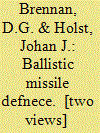

|
|
|
|
|
| Publication |
London, The Institute for Strategic Studies, 1967.
|
| Description |
36p
|
| Series |
Adelphi papers
|
|
|
|
|
|
|
|
|
|
|
|
Copies: C:1/I:0,R:0,Q:0
Circulation
| Accession# | Call# | Current Location | Status | Policy | Location |
| 001356 | 358.17182/BRE 001356 | Main | On Shelf | General | |
|
|
|
|
| 2 |
ID:
114150
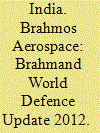

|
|
|
|
|
| Publication |
New Delhi, Pentagon Press, 2012.
|
| Description |
xii, 564p.Hbk
|
| Contents |
Forwarded by M M Pallam Raju
|
| Standard Number |
9788182745186
|
|
|
|
|
|
|
|
|
|
|
|
Copies: C:1/I:0,R:1,Q:0
Circulation
| Accession# | Call# | Current Location | Status | Policy | Location |
| 056739 | 355/IND 056739 | Main | On Shelf | Reference books | |
|
|
|
|
| 3 |
ID:
151617
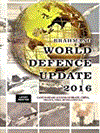

|
|
|
|
|
| Publication |
New Delhi, Pentagon Press, 2016.
|
| Description |
469p.pbk
|
| Standard Number |
9788182748903
|
|
|
|
|
|
|
|
|
|
|
|
Copies: C:1/I:0,R:0,Q:0
Circulation
| Accession# | Call# | Current Location | Status | Policy | Location |
| 058957 | 355/IND 058957 | Main | On Shelf | General | |
|
|
|
|
| 4 |
ID:
159184
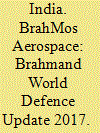

|
|
|
|
|
| Publication |
New Delhi, Pentagon Press, 2017.
|
| Description |
xiii, 411p.pbk
|
| Standard Number |
9788182749443
|
|
|
|
|
|
|
|
|
|
|
|
Copies: C:1/I:0,R:0,Q:0
Circulation
| Accession# | Call# | Current Location | Status | Policy | Location |
| 059402 | 355/IND 059402 | Main | On Shelf | General | |
|
|
|
|
| 5 |
ID:
170612
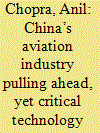

|
|
|
| 6 |
ID:
142976
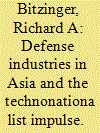

|
|
|
|
|
| Summary/Abstract |
Asia is a region of growing militarization and insecurity. It is increasingly characterized by rising defense expenditures and rapidly modernizing militaries, and subsequently it is increasingly becoming a zone of potential conflict. These security concerns are exacerbated by Asian countries’ expanding capacities for indigenous armaments production. Asian arms production is heavily influenced by concepts of techno-nationalism, which views autarky (self-sufficiency in armaments) as serving not only national defense needs, but also as maximizing national political, strategic, and economic autonomy. The technonationalist model is more than a set of goals; it also embodies a strategy for achieving autarky in armaments production, including the short-term exploitation of foreign-sourced technologies. What is the most interesting about Asian arms industries is how enduring they have been despite the fact that they produce few economic benefits and contribute so little to guaranteeing security of supply or expanding military-technological capacities for national defense. Asian armaments production has rarely been cost-effective or militarily significant in terms of turning out state-of-the-art military equipment. And yet, most large powers in Asia have not abandoned the idea of autarky in armaments production, often with explicit technonationalist industrial strategies. Despite problems with this technological-industrial approach, it is unlikely that these countries will abandon techno-nationalism anytime soon.
|
|
|
|
|
|
|
|
|
|
|
|
|
|
|
|
| 7 |
ID:
034913
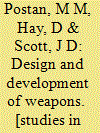

|
|
|
|
|
| Publication |
London, Her Majesty's Stationery Office, 1964.
|
| Description |
xiv, 579p.Hbk
|
| Series |
History of the Second World War; United Kingdom Civil Series
|
|
|
|
|
|
|
|
|
|
|
|
Copies: C:1/I:0,R:0,Q:0
Circulation
| Accession# | Call# | Current Location | Status | Policy | Location |
| 008451 | 940.54/POS 008451 | Main | On Shelf | General | |
|
|
|
|
| 8 |
ID:
052807
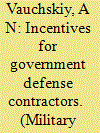

|
|
|
| 9 |
ID:
141601
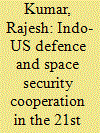

|
|
|
|
|
| Summary/Abstract |
In last one and a quarter decade, it has been seen that successive U.S. governments have sold high-tech arms and military equipment to the Indian government. The momentum for sale of such high technological equipments could be seen from the culmination of Indo-U.S. nuclear deal in 2008. The transfer process has been made easier and the long delays have been reduced and most of the sale is taking through government to government route only. In past such practices could not have ever been imagined. It is this development which has brought important turnaround within their bilateral relations specially, defence cooperation.
|
|
|
|
|
|
|
|
|
|
|
|
|
|
|
|
| 10 |
ID:
121244
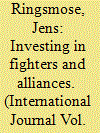

|
|
|
|
|
| Publication |
2013.
|
| Summary/Abstract |
In the spring of 1975 Norway and Denmark were faced with the choice
of how to replace their aging fleets of fighter jets. Together with Belgium
and the Netherlands, the two Nordic countries had established a "buyers'
consortium" to ensure NATO standardization and a strong bargaining
position vis-à-vis the potential suppliers; hence Copenhagen and Oslo
were in very similar situations. As the final decision was about to be made,
three candidate planes were still in the competition: the American F-16, the
Swedish Saab Viggen, and the French Dassault Mirage. After a drawn-out
and exceedingly complex decision-making process, the four European NATO
members together opted for the American contender. Surely, the Danish
and Norwegian decision to procure the F-16 had several reasons behind it-
importantly, most policymakers in both Copenhagen and Oslo considered
the American aircraft to be technically superior to its competitors-but
the choice of the F-16 was in no small part motivated by old-fashioned realpolitik. The purchase of new fighter jets was thus not only perceived as a
procurement of new military equipment but also an investment in alliances
and the transatlantic link. Accordingly, Norway and Denmark chose the
American F-16 partly because this aircraft was thought to bring the greatest
strategic benefits.1
|
|
|
|
|
|
|
|
|
|
|
|
|
|
|
|
| 11 |
ID:
112224
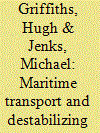

|
|
|
|
|
| Publication |
Sweden, SIPRI, 2012.
|
| Description |
vii, 51p.
|
| Series |
SIPRI Policy Paper No.32
|
| Standard Number |
9789185114719
|
|
|
|
|
|
|
|
|
|
|
|
Copies: C:1/I:0,R:0,Q:0
Circulation
| Accession# | Call# | Current Location | Status | Policy | Location |
| 056469 | 387.5/GRI 056469 | Main | On Shelf | General | |
|
|
|
|
| 12 |
ID:
188414
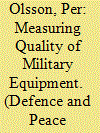

|
|
|
|
|
| Summary/Abstract |
This article aims to present and discuss a method for estimating military equipment quality, while also comparing this approach to previous methods developed with the same purpose. Using main battle tanks as an example, the suggested method’s structure and preliminary results are presented while its potential merits and limitations are also discussed. Preliminary results of the method show that US and western European tanks have traditionally had an qualitative edge. However, they also suggest that modern Russian and Chinese tanks have narrowed this gap. Equipment performance models, such as the one presented in this article, could provide additional insights when assessing the global and regional power balances as well as when estimating purchasing power parities and equipment cost escalation. This article will hopefully encourage further discussion on how to measure and compare military equipment quality.
|
|
|
|
|
|
|
|
|
|
|
|
|
|
|
|
| 13 |
ID:
178092
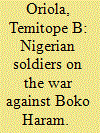

|
|
|
|
|
| Summary/Abstract |
This study explores two main questions: What are the experiences of soldiers who have fought against Boko Haram? What can these experiences teach us about the seeming incapacity of the Nigerian military to defeat Boko Haram? Six major themes are explored. These are perspectives on the mission, morale of troops, military equipment and weapons, suicide and murder–suicide among troops, intelligence leaks, and relationships of troops with the Civilian Joint Task Force, an extralegal militia. Soldiers’ discourses on the mission against Boko Haram reveal three overlapping dimensions. First, there are suspicions about the sponsors and political godfathers of Boko Haram. This suggests a belief that Boko Haram is a conspiracy involving the government and top brass of the military. Second, the patronage system involved in deployment into key positions on the war front. Third, participants believe that the war is being deliberately prolonged because it is a moneymaking machinery for the political and military elites. The evidence suggests that availability of weapons varies by unit and the agency of commanders—their networks and influence within the military and willingness to disobey orders from superiors if their demands are not met. This situation produces radically variegated wartime experiences among troops. Non-commissioned soldiers believe senior commissioned officers perpetrate intelligence leaks and are responsible for the protracted war. Senior Army Generals interviewed in this study support this perspective. The study has major policy implications for successful operations against Boko Haram in the Lake Chad Basin area and the broader war against terrorism in the Sahel.
|
|
|
|
|
|
|
|
|
|
|
|
|
|
|
|
| 14 |
ID:
114040
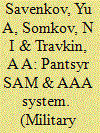

|
|
|
|
|
| Publication |
2012.
|
| Summary/Abstract |
The authors provide the background for the design and production of the Pantsyr combined surface-to-air missile and antiaircraft artillery (SAM & AAA) system, appraise the practical results of upgrades made on its components, and offer an outlook for further system improvements.
|
|
|
|
|
|
|
|
|
|
|
|
|
|
|
|
| 15 |
ID:
130280
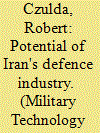

|
|
|
|
|
| Publication |
2013.
|
| Summary/Abstract |
The article focuses Iran's defense industry. Topics discussed include impact of economic sanctions due to the 1979 Islamic Revolution, on Iran's defense industry, international ostracism and development in the Iran's defense system. It further offers information related to the Iranian Air Force, the Iranian Navy and the Iranian unmanned capabilities.
|
|
|
|
|
|
|
|
|
|
|
|
|
|
|
|
| 16 |
ID:
139175
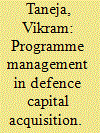

|
|
|
|
|
| Summary/Abstract |
The Indian acquisition canvas in these times is exemplified more by its failings than its accomplishments. Two accidents, one of them fatal, involving utility helicopters in February 2015, have yet again brought to the fore the grim reality of the material readiness in the Indian armed forces, the reluctant clients to a sub-optimal acquisition apparatus. Defence capital acquisition the world over, by its very nature, is a highly rigorous, time consuming and resource intensive domain. In India, acquisition involves multifarious directorates in the Service Headquarters, the Acquisition Wing in the Ministry of Defence (MoD) and the Department of Defence Production (DDP) embodying India’s burgeoning Military Industrial Complex (MIC). Regrettably, India’s armed forces, despite being the biggest arms importer in the world, endure hollowness of critical military equipment. Multiple high level committees since independence have recommended a slew of acquisition reforms, with little realisation on the ground.1 India’s defence modernisation has often been described as a parochial Army effort without the benefit of strong political direction
|
|
|
|
|
|
|
|
|
|
|
|
|
|
|
|
| 17 |
ID:
109284
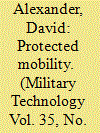

|
|
|
| 18 |
ID:
002035
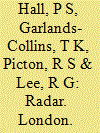

|
|
Radar
/ Hall, P S; Garlands-Collins, T K; Picton, R S; Lee, R G
|
1991

|
|
|
|
| Publication |
London, Brassey's, 1991.
|
| Description |
xii,170p.
|
| Series |
Land warfare: Brassey's new battlefield weapons systems and technology series; v.9
|
| Standard Number |
0080377114
|
|
|
|
|
|
|
|
|
|
|
|
Copies: C:1/I:0,R:0,Q:0
Circulation
| Accession# | Call# | Current Location | Status | Policy | Location |
| 033697 | 355.8/HAL 033697 | Main | On Shelf | General | |
|
|
|
|
| 19 |
ID:
108297
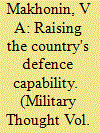

|
|
|
| 20 |
ID:
033568
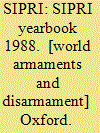

|
|
|
|
|
| Publication |
Oxford, Oxford University Press, 1988.
|
| Description |
xviii, 598p.hbk
|
| Series |
SIPRI Yearbook 1988
|
| Standard Number |
0198291264
|
|
|
|
|
|
|
|
|
|
|
|
Copies: C:1/I:0,R:0,Q:0
Circulation
| Accession# | Call# | Current Location | Status | Policy | Location |
| 030016 | 327.17405/SIP 030016 | Main | On Shelf | General | |
|
|
|
|
|
|
|
|
|